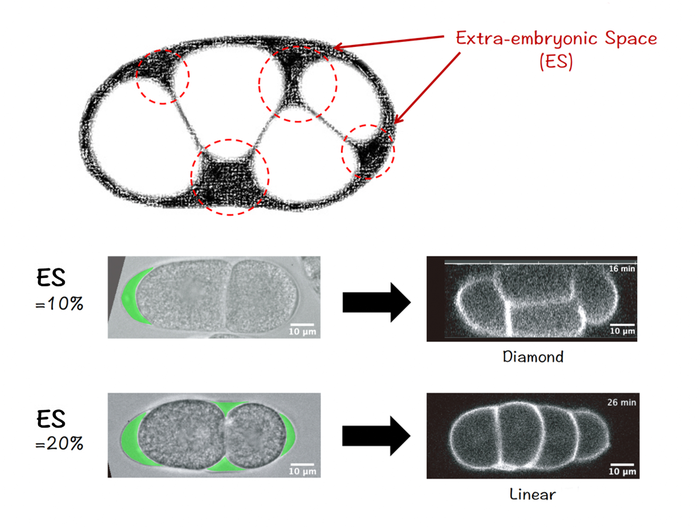Imagine sitting at a meeting where the shape of the table and your place at it might impact how you get along with the other members. Cells also communicate with their nearest neighbors, and in embryos, nothing is left to chance in the ‘seating plan’ for the first few cells. However, questions remain about the how this process is controlled and how it can influence the overall growth of an organism.

Credit: Kyoto University/Sungrim Seirin-Lee
Imagine sitting at a meeting where the shape of the table and your place at it might impact how you get along with the other members. Cells also communicate with their nearest neighbors, and in embryos, nothing is left to chance in the ‘seating plan’ for the first few cells. However, questions remain about the how this process is controlled and how it can influence the overall growth of an organism.
Building on their previous studies on the development of worm eggs, researchers from Kyoto University Kanagawa Institute of Technology, and the National Institute of Genetics have now precisely modeled the shape of eggshells to show how the space in the egg and the contours of the shell direct the relative positions of cells in the growing embryo. Their findings may provide a theoretical basis for directing the development of stem cells into larger tissues and organs.
Lead author Professor Sungrim Seirin-Lee of Kyoto University’s Institute for the Advanced Study of Human Biology (WPI-ASHBi) said, “We had found that when Caenorhabditis elegans embryos reached the 4-cell stage, there are five patterns that the cells arrange themselves in the spaces of the egg. But the T-reverse arrangements we found did not match our previous calculations based on the attraction of the cells and the aspect ratio of the eggs. We realized something was missing from our model.”
When looking under a microscope at eggs of the worm Caenorhabditis elegans, the team previously noticed that in eggs with a longer shape, the first four cells arranged in a line; in contrast, if the shell was round, the cells would bunch up. They also identified an unexplained ‘T-reverse’ pattern in some eggs, where three cells bunch up, making a gap shaped like a T, with one cell in a line at the end.
The team hypothesized that the formation of this pattern, might be controlled by variations in the eggshell contours. To test this, they applied a more sophisticated ‘phase-field’ mathematical model that could more precisely account for the actual egg shape measured from worms. This new model successfully reproduced the previous findings and now also accounts for the unexplained T-reverse arrangement. The findings show for the first time that the previously ignored local contours of the egg affect the cell patterns.
In the new way of looking at the embryo, it turns out that it is actually the “space inside the egg” that is a key factor driving the cell patterns. To test this concept further, the researchers examined the eggs of worms that were genetically modified to allow more space for the cells inside. With extra room, the first four cells preferred to spread out in a line rather than bunching up.
Seirin-Lee said, “Worm eggshells are often treated as a simple oval shape but the actual shape may be closer to a capsule in some cases. We now understand how important geometric constraints and space are for directing cells, and this concept also applies to human cells. We hope this work will lead us to a better handle on artificially controlling cell differentiation and extend the capabilities of stem cell techniques.”
The paper “The extra-embryonic space and the local contour are critical geometric constraints regulating cell arrangement” was published on 12 May, 2022 in the journal Development.
******************
About WPI-ASHBi https://ashbi.kyoto-u.ac.jp/
Institute for the Advanced Study of Human Biology (ASHBi) was launched in October 2018 with funding from the World Premier International Research Center Initiative (WPI) Program of the Ministry of Education, Culture, Sports, Science and Technology (MEXT). The Institute inaugurated with 18 principal investigators (PIs) to create and promote human biology to elucidate key principles of human traits, including disease states. The Institute will perform interdisciplinary research between biology and mathematics (machine learning and topological data analysis) and between biology and humanities/social sciences (bioethics and philosophy on life), respectively. The Institute implements three research development cores for cutting-edge single-cell genome information analysis, primate genome editing, and non-human primate phenotype analysis, respectively. The Institute establishes a link with international institutions such as the EMBL, University of Cambridge, and Karolinska Institutet, creating a stratified organization for research promotion and strengthening its international profile.
Journal
Development
DOI
10.1242/dev.200401
Method of Research
Computational simulation/modeling
Subject of Research
Human embryos
Article Title
The extra-embryonic space and the local contour are critical geometric constraints regulating cell arrangement
Article Publication Date
12-May-2022




